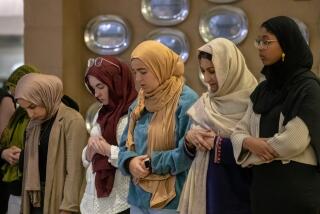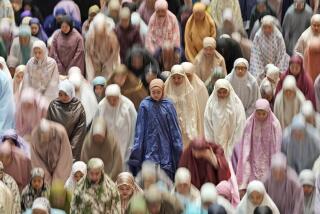RELIGION / JOHN DART : Study Counts Fewer Practicing Muslims : Islam: Adherents in North America total about 500,000, a survey finds. But it remains a fast-growing religion.
- Share via
FOUNTAIN VALLEY — The first scientific survey of mosques has found that organized Islam in the United States and Canada, although growing rapidly, is no larger than a small Christian denomination of about 500,000 adherents, a finding which may sharply lower many previous estimates of the total Muslim population.
The study nevertheless indicated that Islam may be, as reputed, one of the continent’s fastest growing religions, which at the current rate of growth would overtake Judaism early in the next century as the second-largest religious group after Christianity.
Nearly 80% of the 1,046 Muslim congregations, mostly in the United States, were formed in the past 25 years, according to the survey directed by the Islamic Resource Institute of Fountain Valley.
Religious scholars praised the survey as a long-sought starting point for establishing a factual profile of Islam in the United States and Canada, with its mix of mostly Indo-Pakistani and Arab immigrants and African American converts. A summary of the still-unpublished survey is included in a new Muslim resource guide for the news media, of which The Times obtained an advance copy.
“It’s the first solid research in this area,” said sociologist Wade Clark Roof of UC Santa Barbara, who helped construct the poll. Roof is president-elect of the Society for the Scientific Study of Religion.
The survey results should reduce some estimates of the overall American Muslim population, said Ihsan Bagby, who completed the study this year before taking a faculty position in international studies with Shaw University at Raleigh, N.C.
Some previous estimates by scholars and religious leaders have placed the number of Muslims in the United States and Canada at 6 million to 8 million. But because Islamic scholars commonly contend that only 10% of American and Canadian Muslims attend mosques, the new study’s count of about 500,000 mosque-goers indicates a total population of 4.6 million to 5 million, Bagby said.
Conversely, that is well above the 2 million or less estimated by separate national surveys in 1991 by the Gallup Poll and the City University of New York. Islamic leaders disagreed with those findings as too low, saying that new immigrants and black converts are often missed by conventional polling.
By comparison, other studies show there are about 6 million Jews in the United States and Canada. That is only about 20% more than Bagby’s estimate of the Muslim population, even though the number of Muslims was negligible until the 1960s, while Jews have been established in large numbers on the continent for more than a century.
To arrive at the figure of nearly 500,000 Muslims who attend mosques, the survey’s researchers asked each Islamic center how many people take part in activities other than Islam’s two major feast days--one marking the end of the fasting month of Ramadan and another that celebrates the time of the annual pilgrimage to Mecca.
Bagby said that the average number of such active participants per congregation was 465 people, which he multiplied by the 1,046 known mosques--or masjids , an Arabic term for “house of prayer” that Muslims prefer.
Bagby attributed the rapid growth of Islamic centers to a combination of immigration, conversions and births. “Based on immigration and conversion (rates) alone,” he said, “it is safe to say that the Muslim population is growing a minimum of 125,000 a year.” At that rate, the Muslim population would surpass the number of Jews in the United States and Canada by 2010, he said.
Whether many of those people will associate with local Islamic centers is an open question. “The notion of masjid membership is not strong among Muslims,” Bagby conceded.
The survey showed that the actual number of “mosqued” Muslims--those who have taken part in Islamic center prayer activities more than twice a year--may be compared at best to the U. S. memberships of small Christian bodies such as the Church of the Nazarene, the nationwide Wisconsin Evangelical Lutheran Synod and the Orthodox Church in America, an Eastern Orthodox denomination.
Without a tally based on actual mosque attendance, however, it has been difficult to gauge the true numbers of American Muslims.
“I’ve always urged people not to exaggerate numbers of Muslims,” said Salam Al-Marayati, director of the Muslim Public Affairs Council in Los Angeles. “It adds more to people’s apprehensions than to people’s understanding.”
Many Muslims attend no mosque, in part, because in Middle Eastern, African and Asian nations--where it is often the dominant religion--Islam is not organized into the local church congregations common in North America. Moslem immigrants are thus unaccustomed to establishing such affiliations, Islamic leaders say.
Bagby said that the study was conducted from mid-1992 to last March through telephone interviews with representatives of 341 mosques.
“Only a handful, fewer than 10, refused to participate,” Bagby said.
“This is the most accurate study to date,” said Yvonne Haddad, a much-published scholar on Islam in America. Haddad, who teaches at the University of Massachusetts, noted that Bagby “had every big gun in Islamic leadership in North America supporting his research.”
One expected finding was that most masjids are multicultural. Seven of every 10 masjids have more than one ethnic group worshiping there, Bagby said. Either African Americans or Indo-Pakistanis were the largest groups at most masjids, followed closely by Arab Americans.
The New York City area has the largest number of masjids, 98, followed by the Chicago metropolitan area with 60 and Southern California with 55, the study said.
But Southern California ranked second highest in estimated total attendance at the traditional midday Friday prayers at its 55 masjids, with 11,858 worshipers, compared to more than 27,000 in the New York area. (Devout Muslims are expected to pray five times daily, at home or work, and to attend a Friday service, if possible.)
The states with the largest numbers of masjids were New York (132), California (117), Illinois (74), New Jersey (60) and Texas (58). The highest attendance at Friday prayers was reported by 31 masjids in Washington, D.C.--with an average of 472 people each--and the 33 masjids in Toronto and the rest of the Ontario province of Canada, with an average of 328, the study said.
The average Friday attendance in Southern California masjids was reported to be 242 people, a figure which fails to reflect the much larger attendance at some major masjids.
For example, the large Islamic Center of Southern California on Vermont Avenue in Los Angeles attracts between 1,000 and 1,500 people every Friday, according to Al-Marayati. And about 1,000 also attend services at the Islamic Society of Orange County in Garden Grove, he said.
In the San Fernando Valley, combined attendance at two prayer services of the Islamic Center of Northridge on a recent Friday was between 320 and 360, said Hasan Mulla, director of the masjid. The Northridge masjid, which was organized in 1977, is currently constructing a new building in Granada Hills just north of the Simi Valley Freeway.
Smaller Valley area masjids hold Friday prayers in Van Nuys, North Hollywood and Santa Clarita.
Islam in this country has loose federations rather than denominations. The survey found that 39% of the masjids are affiliated with the Islamic Society of North America, based in Plainfield, Ind., but 30% say they are independent. The next largest segment, 20%, follows the lead of Imam W. Deen Mohammed of Chicago, who has steered the once-sectarian Black Muslim movement into the Islamic mainstream over the last two decades.
The Nation of Islam, headed by controversial Minister Louis Farrakhan, was not included in the survey, Bagby said. “The masjids we dealt with recognize each other as all belonging to the mainstream of Islam,” and they do not consider Farrakhan’s group in that mainstream, he said.
Organized Islam
Mosques, called masjids or Islamic centers by Muslims, have been forming at a rapid rate in the U.S. and Canada in recent decades. Nearly 80% of the existing 1,046 mosques were organized in the last 25 years.
Years mosques formed: Before 1960: 11% 1960-69: 11% 1970-79: 28% Since 1980: 50% Sources: National Survey of Masjid Communities, Islamic Resources Institute, Fountain Valley, Calif.
More to Read
Sign up for Essential California
The most important California stories and recommendations in your inbox every morning.
You may occasionally receive promotional content from the Los Angeles Times.













